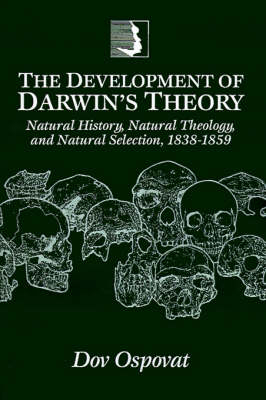
The Development of Darwin's Theory
Natural History, Natural Theology, and Natural Selection, 1838–1859
Seiten
1995
Cambridge University Press (Verlag)
978-0-521-46940-1 (ISBN)
Cambridge University Press (Verlag)
978-0-521-46940-1 (ISBN)
In this highly acclaimed book, Ospovat shows that Darwin's views changed radically from his first formulation of evolution to the publication of the full theory in 1859.
Dov Ospovat's book, originally published in 1981, has become generally accepted as one of the most influential books about Darwin published in recent years. Ospovat examines the period of 1838–1859 in detail, and shows that Darwin's views changed quite radically from his initial belief that animals and plants were perfectly adapted to their environments, and that evolution only occurred when the environment changed, to believing that living things were not perfectly adapted, were in constant competition with each other and hence, were continually evolving. By placing Darwin within the other biological developments of the day, Ospovat is able to show that he was not the scientific recluse of popular myth, that there was a theological basis for much of Darwin's original 1838–1844 theory and that his later 'principle of divergence' was influenced by his belief in evolutionary progress. This seminal work should be read by all those interested in the history of modern biology.
Dov Ospovat's book, originally published in 1981, has become generally accepted as one of the most influential books about Darwin published in recent years. Ospovat examines the period of 1838–1859 in detail, and shows that Darwin's views changed quite radically from his initial belief that animals and plants were perfectly adapted to their environments, and that evolution only occurred when the environment changed, to believing that living things were not perfectly adapted, were in constant competition with each other and hence, were continually evolving. By placing Darwin within the other biological developments of the day, Ospovat is able to show that he was not the scientific recluse of popular myth, that there was a theological basis for much of Darwin's original 1838–1844 theory and that his later 'principle of divergence' was influenced by his belief in evolutionary progress. This seminal work should be read by all those interested in the history of modern biology.
List of illustrations; Preface; Acknowledgements; Note on manuscript citations; Introduction: Darwin and his fellow naturalists; 1. Darwin and the biology of the 1830s: some parallels; 2. Darwin before Malthus; 3. Natural selection and perfect adaptation, 1838–1844; 4. Part II of Darwin's work on species; 5. Natural history after Cuvier: the branching conception of nature; 6. Darwin and the branching conception; 7. Classification and the 'principle of divergence'; 8. The principle of divergence and the transformation of Darwin's theory; 9. Natural selection and 'natural improvement'; Conclusion: the development of Darwin's theory as a social progress; Notes; Bibliography; Index.
| Erscheint lt. Verlag | 28.4.1995 |
|---|---|
| Zusatzinfo | 6 Halftones, unspecified; 3 Line drawings, unspecified |
| Verlagsort | Cambridge |
| Sprache | englisch |
| Maße | 152 x 228 mm |
| Gewicht | 429 g |
| Themenwelt | Naturwissenschaften ► Biologie ► Evolution |
| ISBN-10 | 0-521-46940-6 / 0521469406 |
| ISBN-13 | 978-0-521-46940-1 / 9780521469401 |
| Zustand | Neuware |
| Haben Sie eine Frage zum Produkt? |
Mehr entdecken
aus dem Bereich
aus dem Bereich
Komplette Neuübersetzung. Mit einem Nachwort von Josef H. Reichholf.
Buch | Hardcover (2018)
Klett-Cotta (Verlag)
48,00 €
Wie die Vernichtung der Arten unser Überleben bedroht - Der …
Buch | Softcover (2023)
Penguin (Verlag)
15,00 €


